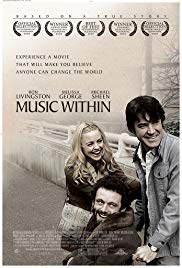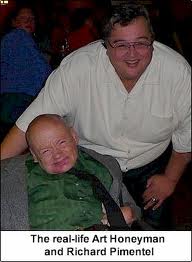INTO: INTRODUCTION & FILM STUDY WORKSHEET
An introduction is necessary for students to fully appreciate the movie. The information below should be delivered through direct instruction or by having students read it as a handout. Click here for a word processing version of the handout. Edit, supplement or subtract from these materials as appropriate for the classes to which they will be given.
Most of the events shown in this film actually occurred. Richard Pimentel is one of the people responsible for the passage of the Americans With Disabilities Act in 1990. That law requires restaurants and public facilities to install wheelchair ramps or elevators and requires that the disabled be given reasonable accommodations in employment. The characters of Art and Christine are also based on real people.
Up to 1974, less than 40 years ago, people could be arrested just for being ugly in public. “Ugly Laws” were enacted in western and mid-western U.S. cities as part of urban reform movements in the late 1800s. They were designed to regulate and sanitize rapidly growing cities by keeping them clear of beggars, some of whom were able-bodied hustlers pretending to be injured or handicapped. The laws were originally intended to get the physically deformed and mentally impaired into the minimally charitable almshouses, end begging by the non-impaired, and placate merchants. Later, classism and racism combined with the feelings of unease in the presence of the disabled to create individual and institutional prejudice against the handicapped. The first ugly law was enacted in San Francisco in 1867. Similar statutes were eventually enacted in other states and then in other countries. The last Ugly Law in the U.S. was repealed in 1974 in Chicago. The Ugly Laws — Disability in Public by Susan M. Schweik, New York University Press, 2009.
Several characters in the film are veterans of the Vietnam War, a war which became very unpopular in the United States. Many people did not welcome soldiers who came home from the war, believing that vets supported the war. Civilians often feared Vietnam vets because they used drugs and suffered from Post Traumatic Stress Disorder (“PTSD”). PTSD is an anxiety disorder that many people experience after living through a dangerous or frightening event. For example, soldiers, plane crash survivors, and eyewitnesses to shooting rampages can suffer from PTSD. Nightmares, flashbacks, outbursts of anger, depression, and suicidal thoughts are some of the symptoms of PTSD. Post-Traumatic Stress Disorder (PTSD) from the National Institute of Mental Health; downloaded February 26, 2011. Several of the vets shown in this movie suffers from this condition.
One of the characters in the movie suffers from what is called “early childhood trauma.” Recent research findings show that overwhelming adverse experiences early in life such as the loss of one or both parents, or living with an emotionally disturbed or alcoholic parent, may alter the chemical wiring of the developing brain. This is sometimes called early-life trauma, although the trauma referred to is not the extreme violence or risk of injury or death involved in PTSD. Early-life trauma can result in psychological problems later in life, as well as physiological and physical illness such as chronic fatigue syndrome. A 2010 study in collaboration with Emory University concluded that “There is ample evidence . . . that adverse experience early in life, during periods of heightened brain plasticity, permanently programs the development of multiple brain circuits involved in the processing of environmental stimuli and the regulation of behavioral, autonomic, and endocrine responses to stress.” Association of childhood trauma with cognitive function in healthy adults: a pilot study by Matthias Majer, et al, 2010, published by BioMed Central. New treatments, some using drugs and some using psychological therapy, have been developed to treat the effects of early childhood trauma.
A study published in the Journal of Traumatic Stress in 2010 cited trauma in childhood as a risk factor for obesity in adulthood. Almost 80 percent of the women in the study had PTSD, depression, or both. The women who reported abuse were more likely to experience PTSD and depression and were also more likely to be overweight in adulthood. Trauma in Childhood Could Contribute to Obesity in Adults in NewsWise, accessed February 27, 2010. Finally, another effect of early childhood trauma is increased susceptibility to PTSD later in life.
Cerebral palsy (“CP”) is a medical condition suffered by one of the characters in the movie. It is defined as “[A] disorder of movement, muscle tone or posture that is caused by injury or abnormal development in the immature brain, most often before birth.” Mayo Clinic Website. CP is neither progressive nor contagious.
Finally, one of the characters suffers from tinnitus, a ringing, whistling, or whooshing sound inside the ear or head without a corresponding external sound stimulus. The Mayo Clinic’s web page states, “tinnitus affects about 1 in 5 people. Tinnitus isn’t a condition itself — it’s a symptom of an underlying condition, such as a traumatic injury to the inner ear, age-related hearing loss, ear injury or a circulatory system disorder.” Moderate to high-level in-ear headphones, heavily amplified music and noisy industrial environments can also cause both tinnitus and hearing loss. Like many disorders, the syndrome occurs along a continuum. Some people are severely disabled by persistent, invasive ringing. Others notice it only when they read or think about it. Mayo Clinic Website Article on Tinnitus accessed February 27, 2010.
Before starting the film, hand out TWM’s Film Study Worksheet for Social Studies Classes adapted specifically for this film and have the students read it before they see the movie. Be sure to remind them to listen to the lyrics of the songs on the soundtrack. In this movie, the lyrics often match or comment on what is occurring in the film.






